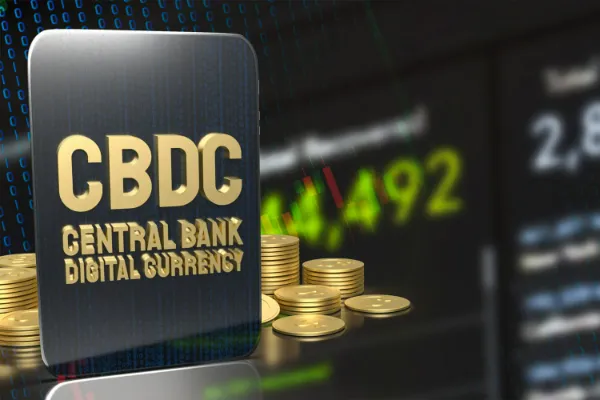In recent years, the way we use money has started to change. More and more people are paying with apps, debit cards, and online platforms instead of using cash. As digital payments grow, central banks around the world are working on a new kind of money: Central Bank Digital Currencies (CBDCs). These digital currencies could become a major part of how we spend and save in the future.
What are CBDCs?
Nationals can utilize Central Bank Digital Currencies which represent the digital form of their official monetary unit such as the U.S. dollar or euro. A Central Bank Digital Currency emerges from the central authority responsible for monetary issues such as the Federal Reserve of the United States or the European Central Bank of Europe. A key distinction between CBDCs exists since the digital currencies lack both decentralization and privacy elements that Bitcoin possesses. The government provides full support for these digital currencies to match the backing provided to conventional paper money.
CBDCs exist in retail and wholesale versions as the primary forms. Regular users can access retail CBDCs to conduct transactions using digital devices instead of traditional cash usage. The banking sector and large financial institutions utilize wholesale CBDCs for their mutual funds transfers.
Why Are Countries Interested in CBDCs?
Several governments are interested in exploring CBDCs because of these key factors. The use of cash continues to decrease across numerous countries within the modern world. Public institutions want to preserve a dependable digital payment system because they observe customers shifting toward private payment providers such as PayPal and Apple Pay. A CBDC could be that option.
The implementation of CBDCs aims to assist people who lack access to banking services. The lack of bank accounts exists in multiple areas particularly across developing nations. The combination of digital currency authority by the central bank enables people to perform transactions through their smartphones alone.
The implementation of CBDCs would enable faster and cheaper payment processing particularly for overseas financial transfers. The current system of moving money internationally demands many days and involves costly fees. The implementation of CBDCs would reduce this process duration to near instantaneous speed.
The administration recognizes CBDCs as an opportunity to maintain overall control of their financial systems. Stablecoins (digital currencies linked to regular currency) have been developed by private enterprises yet governments want to maintain control over monetary operations.
What’s Happening Around the World?
Countries worldwide are presently situated at varying levels of CBDC development. The digital yuan from China has reached public deployment in cities where citizens use it for transportation as well as shopping and government transactions. The country of Bahamas became the initial nation to introduce its complete digital currency titled Sand Dollar in 2020. The eNaira blockchain program from Nigeria started operation to assist individuals who remain unconnected to banking services.
The development of a digital euro stands at present as a plan under European oversight. The system is projected to reach readiness sometime within the following few years. The Federal Reserve in the United States continues its research activities without establishing any official stance. Banks together with privacy protection forms one of the main issues associated with digital currencies.
What Are the Concerns?
CBDCs carry many advantages to users but multiple risks exist. Privacy issues are the primary major worry among the public. Under government control of digital currency the government can monitor complete spending details about every dollar transaction. Surveillance methods coming from government authorities create concerns about personal freedoms.
CBDCs pose risks to typical banking institutions as they go into circulation. CBDC adoption as the primary money storage method by citizens could result in decreased available funding for car loans and mortgages because banks would have less account deposits. The economic stability requires new payment procedures to be developed in order to prevent financial damage.
Online security stands among the major current difficulties. Digital currency systems operate as attractive attack targets for cyber hackers. For digital currencies to succeed in the market central banks require efficient security solutions to defend money against potential digital assaults.
Last of all it becomes difficult to establish interoperability among different countries utilizing CBDCs. Different nation-based approaches to system development could make international cooperation between countries challenging. The establishment of CBDCs would lead to more complicated international payment processes instead of simplified ones.
Looking Ahead
The concept of CBDCs is currently evolving rapidly even though it remains new. One hundred plus countries have initiated CBDC investigations while multiple nations have implemented functional or under-development systems. The next decade will probably see widespread use of digital currencies provided by national governments throughout numerous nations worldwide.
The main question regarding CBDCs is what their effect will be on common daily activities for the population. Will we still use cash? Commercial banks face an unanswerable question regarding their ongoing significance. Will governments protect our privacy? The developing technology requires immediate responses to numerous critical questions.
Digital transformation becomes evident as the world evolves to use digital money for its transactions. Similar to other digital transformations that took place in music and photos and communication sectors, money transitioned into the online realm. Future generations should expect CBDCs to become the typical form of money while high school seniors need education about this economic transition for their upcoming adulthood.
Sources
https://www.federalreserve.gov/cbdc-faqs.htm
https://www.investopedia.com/terms/c/central-bank-digital-currency-cbdc.asp
https://www.cato.org/visual-feature/risks-of-cbdcs
https://www.imf.org/en/Blogs/Articles/2023/11/20/central-bank-digital-currency-development-enters-the-next-phase
Image: https://hls.harvard.edu/today/establishing-a-us-central-bank-digital-currency-the-right-time-or-too-risky/ + Getty Images/niphon

